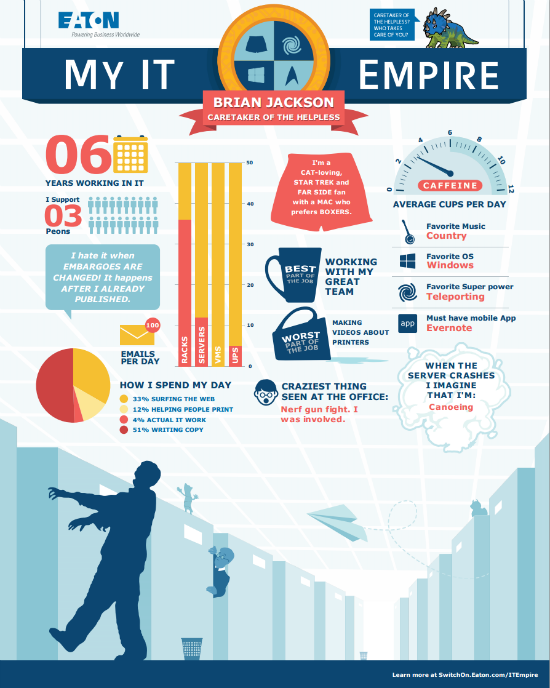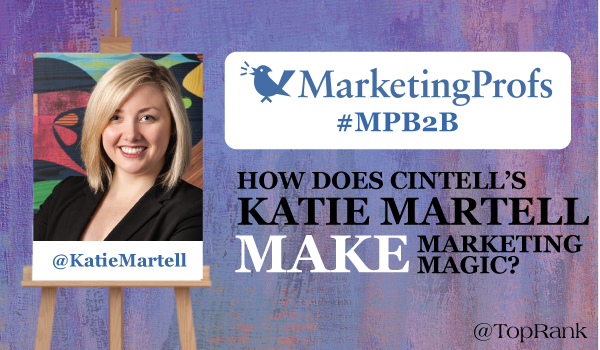Our biggest job as marketers is to lead customers to the conclusion that we are the best answer for their business problems. The first step in leading your customers down the logical path to choosing your company, is understanding who they are, what they care about and the things that impact their purchasing decisions.
Creating buyer personas can help you identify your best customers and create a marketing strategy that targets their needs. Recent research has found that incorporating buyer personas made websites 2 – 5 times more effective and easier to use by targeted users.
This week B2B marketers will have an opportunity to learn about personas, marketing planning and a vast variety of other related topics at the MarketingProfs B2B Marketing Forum (October 20 – 23). To provide you with a preview, we have our final interview in this series with Katie Martell, CMO and Co-Founder of Cintell. In this interview Katie provides some powerful insights into persona development, how she approaches creative marketing and what inspires her to MAKE marketing magic.
What are the biggest mistakes that marketers make today when it comes to buyer personas?
Our team at Cintell gets a chance to work with a lot of marketers during their journey to becoming customer-centric. Some make mistakes when building personas for the first time, others trip up when trying to put personas to work inside their companies.
When building personas, some of the most common mistakes we’ve seen are:
- Limiting insights to segmentation criteria like job title and industry, or useless information for B2B like the car they drive, rather than really discovering the buyers’ problems and preferences.
- Using only internal opinions to form personas, rather than involve primary research (talking to customers) or external insights (third-party research and data).
- Creating too many personas. This is a very common mistake. A rule of thumb is that each persona should represent a segment of the market, and you should have bandwidth to serve them accordingly.
When operationalizing personas, common mistakes include:
- Hiding personas in binders, on intranets, or in static PDFs where they’re hard to find and keep current.
- Rarely updating personas to reflect changes that occur such as regulatory (new compliance laws) economic (hard times in specific industries), trend-related (hot topics, influencers, issues) or demographic (new or retiring buyers).
- Failing to gain buy-in from other functions such as sales, product, or the C-suite related to the value of personas, and their application in the business. The potential of personas is to unify an organization around one common view and definition of the buyer, so companywide decisions are more relevant and customer-centric. This can only be achieved if executives have “bought in” to the idea and the data itself.
- Failure to incorporate feedback. Part of achieving buy-in is allowing for stakeholders in the business to give their two cents. You can balance opinions with the hard facts you find in research, but just opening the channel of communication is often enough to earn the support of this initiative across the business.
What are some of the major benefits of using personas when it comes to making marketing magic?
Think back to a GREAT date you’ve had. There’s a feeling of mutual understanding, and you’re immediately comfortable, because this person truly listens to you, and keeps the conversation moving effortlessly with relevant topics and a style that matches yours. It’s chemistry. They just get you.
I may be stretching the truth a bit here, but that chemistry is possible in the B2B buying process. Wait, don’t roll your eyes, hear me out – people respond to marketing when it demonstrates empathy. When the marketing message they’re reading, seeing, or hearing matches their tone and style and reflects the problems they’re faced with every day. Marketing magic in 2015 is not just about being the loudest brand seen on every possible channel. It’s about being the brand that demonstrates they know their buyer best, where buyers think “they just get me.”
The business impact of being customer-centric is well documented. Deloitte and Touche found that customer-centric companies are 60% more profitable than those not focused on the customer. (What are they focused on?) More tactically, campaign tests have shown that persona-based marketing leads to an increase in open rates and click-through-rates, and that customer-centric organizations have happier customers.
There is real, lasting business impact once companies decide to stop operating under a product-first mindset, and instead use customer insights to guide their strategy.
How can companies be more creative and effective at understanding their prospective customers?
There’s been plenty written over the last 15+ years about the importance of creating buyer personas and advice for conducting the phone interviews and surveys needed to discover the right insight. Even with this advice, and a plethora of consultants available to help, plenty of companies still struggle to get the basics of persona development right.
Among enterprise B2B organizations, companies are still operating in a kind of bubble when it comes to understanding their buyers. ANNUITAS found that only about half of these organizations interview their customers, and only 34% speak with prospects when developing buyer personas. Developing personas in such an insular way is dangerous, as it results in biased and unreliable perspectives of buyers. It’s one of the major reasons why personas fail.
Once you’ve got the basics down, the state of marketing technology in 2015 allows you to find insight in more places that can help with persona development. For example, analyzing the behavior of contacts in your marketing automation system can validate some of the assumptions you’ve made about these buying segments. Seek to create a feedback loop between your persona definition and your system. Marketers can also leverage progressive profiling in their marketing automation tools to continue to collect information about buyers beyond the standard demographic fields. Try asking questions related to persona insights such as priorities or motivations.
One effective method of understanding buyers that many organizations fail to apply is incentivizing your front-line employees to give feedback. Once you’ve published personas companywide, be open to feedback from sales and service on their accuracy and relevance. These teams can help your personas remain current.
What are some approaches or processes that you follow in the making of creative content?
I have two checks that are my personal rules-of-thumb when creating content.
The gut-check. Is this something I feel good about, deep down? Would I actually read this? Am I proud of this content and its message or have I been too wishy-washy in quashing the point and meaning of the piece? It’s easier at a small company like mine to publish content that doesn’t get over-edited by a team of people all with differing opinions. That’s where personas can really help guide content creation – if the team lives by the simple rule that content must align to what the buyer needs, not everyone’s opinion in the room, there may be less of the death-by-democracy we often see that kills content creativity and effectiveness.
The you-check. Check your website copy, or the last email campaign you wrote, or even the last whitepaper you published. What percentage of it is about the buyer? What percentage of it is about you? Of course there’s a balance to be struck, but overwhelmingly most companies are the center of their own universe, and the content from website copy to press releases reflect as much.
One of our users recently conducted persona research and discovered the word choices used by his customers were vastly different than the ones used internally on his product team. He opened his website and realized the copy reflected this internal bias, not the words and tone that would resonate with his buyers. He’s working now to adjust the copy, and this will extend to his content teams and across the business.
We all know the B in B2B doesn’t mean boring, so what examples of magical B2B marketing can you share?
I love creative yet practical campaigns that still meet business objectives while treating buyers as human beings. A good friend of mine put this mantra into practice recently with a fantastic campaign “My IT Empire” targeted at the increasingly hard-to-reach IT professional audience. The agency in this case is Jack Morton and their client, Eaton.
Seeking to outperform business-as-usual lead generation efforts such as white paper, webinar, and eBook form submissions, which were found to be increasingly unpopular with this particular audience, Eaton wanted to show it understood the audience as humans and professionals. They created a digital tool that collected 48 data points (be still my heart) per user, and generated a custom infographic which was then printed and mailed to the user for free.
I simply love this campaign because it not only collected critical information about each user’s IT realm such as server and data center stats (much of which can lead to highly relevant qualification and follow up), it asked questions these users rarely saw on lead forms related to their personalities. Star Wars or Star Trek? What’s the worst part of your job? Even, yes, their underwear preference. Users offered up the information in droves (216k+ data points gathered on prospective customers) proudly hung the infographic on their walls, and positioned Eaton as a relevant, humanized, customer-centric brand.

What inspires you to MAKE marketing magic?
It’s a fantastic time to be in B2B marketing, because the world of buying and selling in this space has changed for good. The skills that are required to be a successful marketer today are a fantastic mix of technology and analytics, management, listening, empathy, and creativity. It’s just not good enough anymore to batch, blast, and carry on with myopic, product-centered strategy. This is a good thing for both customers and marketers. It raises our game. It makes our industry and what we do more relatable, more empathic, and more human.
I’m continually inspired by the marketers in our space who are evolving to connect with new, empowered buyers; satisfy increasingly stressful quotas and growth plans; encourage creativity and humanity in their businesses and somehow manage to keep their head on straight.
Every week we’re learning of new technology available to accelerate and improve our tactics, and we’re building new ways to get at hard-to-find customer insight. With so much information at our disposal, so much training, so many new ideas published at the speed of light online, it’s never been easier to continually evolve as a marketer and “always be learning” – a mantra we live by as a company and is good advice for every marketer today.
MAKE Your Own Marketing Magic
Thanks for your insight Katie!. If you want even more B2B marketing smarts from some of today’s top marketers be sure to check out the MarketingProfs B2B Marketing Forum.
If you’re already planning on attending MarketingProfs B2B Forum, be sure to check out TopRank Marketing CEO Lee Odden’s session, Participation Marketing: If You Want B2B Content to Be Great, Ask Your Community to Participate.
Header image via Shutterstock
![]() Gain a competitive advantage by subscribing to the
Gain a competitive advantage by subscribing to the
TopRank® Online Marketing Newsletter.
© Online Marketing Blog - TopRank®, 2015. | How Does Katie Martell of Cintell MAKE Marketing Magic? #MPB2B | http://www.toprankblog.com
The post How Does Katie Martell of Cintell MAKE Marketing Magic? #MPB2B appeared first on Online Marketing Blog - TopRank®.

No comments:
Post a Comment